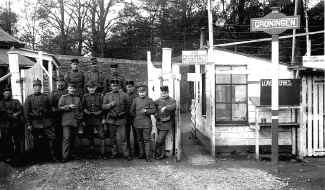|
to
English Camp page
next page
|
Internees taken prisoner of
war during compassionate leave
The English Camp in Groningen 1914 – 1918 (part 8)
This is the eighth article from a series of 13 on the history of the English Camp at Groningen, Holland, where 1,500 British servicemen were interned during the Great War 1914 – 1918.
 |
| Picture of the access
gate, taken from within Camp, with a number of Dutch guards and their
officers. In the background the prison wall. The sign ‘Groningen’ is
interesting, as it indicated to the British that they left ‘British
soil’ and were from that point onwards subject to Dutch
legislation. The office to the right served as payment office for
wages; visitors and people making delivery had to report for departure
there. |
As noted before, British officers were not housed in the camp. They were allowed to seek housing in the city of Groningen. They had another privilege over NCOs and men: they were allowed home leave in the United Kingdom. This had been laid down in law during the The Hague Peace Conference of 1907. This was generally held to be unjust. The commander in chief of the Dutch army, general C.J. Snijders, therefore allowed an NCO 14 days’ compassionate leave because his wife was seriously ill. When further such cases surfaced a request for leave had to be officially supported by a British doctor or other person in authority.
General Snijders found leave on humanitarian grounds a matter of course. He had therefore not consulted the government in The Hague. When one Brit failed to return on time from his leave in April 1915, there was the devil to pay. The Netherlands’ government was displeased and the Foreign Minister told general Snijders he had acted without consideration. Snijders replied that anyone found to have abused the system would forfeit the right to home leave. The internee in question had not stayed behind deliberately. It appeared, on checking with British authorities, that he had to wait for a ship to take him back.
Transport to England was fraught with danger at any rate. There was always the risk of U-boat attack. Three men on leave (H.J. Selkirk, R.H. Guppy and J.D. Ewings) were killed when the SS Copenhagen was torpedoed in 1917. A similar tragedy befell another group on leave in September 1916. They were sailing on board the Dutch freighter 'Prins Hendrik' from Flushing to England when the vessel was stopped by the Germans for a cargo check. The ten British internees, travelling in uniform, were taken from the ship and transferred to Germany as prisoners of war. Official protests from the Dutch government were to no avail. The Germans regarded the men as combatants from a hostile nation, which gave them the right to take them as PoW’s, in their opinion.
The compassionate leave arrangements proved to be very necessary. So much so, that in January 1917, about 350 internees were in the United Kingdom because of ill health of ‘next of kin’. All these requests were officially supported by the British authorities. The period of leave was commonly one month, usually extended to two months. In Holland, the question was asked whether ‘illness of next of kin’ was not simply an excuse to go on leave.
The British side then requested that the ‘compassionate leave’ arrangements be changed into a general arrangement, in order that each individual internee could go on leave on a regular basis. The British government would be guarantor for the return of the internee. The Dutch government hesitated for a while, because such an arrangement would also have to apply to German internees, who were held in a camp at Bergen, north of Amsterdam.
In 1917, group leave was officially sanctioned. And of course, this was accompanied by a set of rules. Leave would be allowed to all British servicemen who had been well behaved over the past four months. Each month, one group would be allowed home, but a new group would not be allowed until the previous one had returned. Compassionate leave would be regarded as ordinary leave. The British would not be allowed to do work related to trade or war. The first group of 135 men and 5 officers left in June 1917. The arrangements for group leave were applied generously, demonstrated by the fact that at the time of the Armistice, in November 1918, more than 300 Britons were at home on leave.
Next: State of Siege declared in Groningen
  to
English Camp page to
English Camp page
|
|